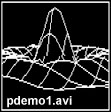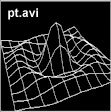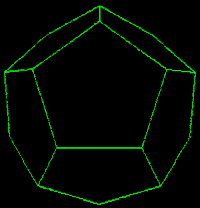Note: The animations have been converted from the Video Genie HiRes pixel by pixel so the aspect is wrong; on the Video Genie these images were approximately square in aspect. The screen was 384 by 192 pixels, so the images were also a bit larger than what you see on a modern computer. All the other images have been converted from screen-prints and those from the Video Genie have been adjusted so that the aspect is as it was.
|
|
The gif animations on this page are reproductions of Video Genie HIRES programs. Note: the aspect in the gif animations are wrong. I made them sometime early 1983, just before I had floppy-drives so it was cassette based. There was a basic program that would generate each frame and save them to cassette. This data would then be merged and an optimized assembly program would display the data. I had never seen anything like this and the sense of 3D was stunning the first time I saw it, it was so real and no trick. Here are two avi's made with the HT1080Z emulator. They are just like the real thing. |
 pdemo1.avi (716K) |
 pt.avi (750K) |
A funny thing is that I also explored diffuse reflection, at about the same time, of which the hires screenprint below is an example. Unfortunately I never combined the two. The result might have been even more stunning. The lack of greytones in the hires (or printer) meant that dithering was the only means of varying the intensity of the reflected light.  In later years I have used tools others have made like
©2001 Knut Roll-Lund |
 I created
myself a model based on me sitting half a meter away from the screen looking
at an object through the screen as if the screen was a window. This screen
was of course a flat plane in space based on the "looking at" and "down"
vectors. The vector based formulas became very simple to compute, and without
the trigonometric functions it was much faster. The hidden lines bussiness
became a bit more difficult but, by expanding the original scheeme a bit,
it still worked. The first images came from models of the all the basic
polyhedron. Actually the tetraeder was not very spectacular so it never
got saved even. I then made the more spectacular mathematical function
representation, f.ex. sin(r)/r the one in the animations on the top and
below.
I created
myself a model based on me sitting half a meter away from the screen looking
at an object through the screen as if the screen was a window. This screen
was of course a flat plane in space based on the "looking at" and "down"
vectors. The vector based formulas became very simple to compute, and without
the trigonometric functions it was much faster. The hidden lines bussiness
became a bit more difficult but, by expanding the original scheeme a bit,
it still worked. The first images came from models of the all the basic
polyhedron. Actually the tetraeder was not very spectacular so it never
got saved even. I then made the more spectacular mathematical function
representation, f.ex. sin(r)/r the one in the animations on the top and
below.